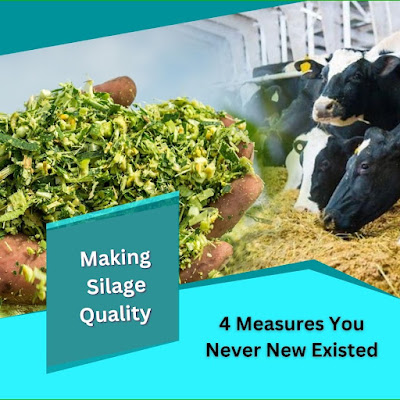How is Silage Made?
The intention of
silage manufacturing is to limit organic degradation and preserve digestible
vitamins. For This, Oxygen must be removed, and silage acidity should grow
hastily so that lactic acid microorganisms grow and stabilize the Silage. The
four levels are the aerobic phase, lag phase, fermentation phase, and
substantial segment. By ceasing the fermentation, silage temperature should
attain a final low pH, preventing bacterial increase. Fast silo filling,
correct packing, and tight sealing are vital for oxygen removal. Particle
length and moisture content material will affect packing. Silage with precise
aerobic balance (bunk existence) has minimal heating after feed out.
How Silage is Prepare
During
the Silage making technique, the pasture is cut while the grasses
incorporate the best nutrient tiers. This stage is attained just before they're
entirely mature.
Process In Silage
Making:
Selection of Crops
and Picking Right Time For Cutting
The choicest dry
remember for crop harvesting for Silage depends on the level of Harvesting.
Most crops are harvested at 50% flowering to dough degree when the moisture
content varies between 18-22%. After overnight wilting, the dry remember
content material comes to be 30-35% which is right dry retain content for
ensiling.
Steps of
Making:
Silage making
can be divided into six steps to understanding easily.
Making Pit:
Firstly, a silage pit
must be dug for storing Silage. The pit size may be determined primarily based
on the amount of Silage to be stored. For example, hole size of one meter
extensive X 1-meter duration X 1-meter depth can shop 500 kilograms of Silage.
Fermentation
Mixture:
○ For preparing a
1-ton silage, the following materials are required.
○ Jaggery or Molasses
– 1 Kg
○ Salt – 1 Kg
○ Mineral Mixture – 1
Kg
○ DCP (Di-Calcium
Phosphate) – 1 Kg
○ LAB (Lactic Acid
Bacteria)
○ Urea – 1 Kg
○ Mix them all well
with water
Harvesting and
transportation of crop (ensiling):
Farmers can easily
maintain Harvesting, but it could lead to reduced moisture if transportation
got some dealing.
Chaffing:
It needs to be
chaffed into small pieces, preferably 2-4 cm, before using a chaff cutter. This
improves the packing density, which favors the growth of the lactic acid
microorganisms, obviously found in crops. Next, add the fermentation aggregate
in small quantities because the fodder is loaded to the chaff cutter. Keep
cutter in Position, so the chaffed fodder directly falls into the silage pit.
Level the chaffed pieces flippantly and press them hard so that every one air
comes out. Packing and eliminating air could be very critical.
Filling of silo and
compaction:
Chaffed fabric must
be spread frivolously over the entire surface of the silo (the structure) and
then compacted through trampling (in case of a small silo). In the case of the
huge silo (trenches), the compaction can be carried out using a tractor. It
helps in speedy evacuation of air from the silo, hence assessments the
cardiorespiratory and nutrient loss.
Properly sealing and
covering of silo pit:
It should be
completed in this manner that neither air enters into the silo nor the gasoline
comes out from the silo. It is higher to apply polythene sheet, but care must
be taken that the entire floor of polythene sheet has to be covered with straw
or any other dried material up to 6-eight inch thickness to keep away from the
harm of polythene sheet by means of canine, cat or different animals. Make sure
water cant enter the pit in the course of rain. The Silage will take 45 to 60
days to get ready, relying on the forms of materials used. After the final
touch of incubation duration, the silo is opened for feeding.
In India, Some
companies like Silage Agro manufacture good
quality silage with European machines that help Silage stay more than 2 Years.



Comments
Post a Comment